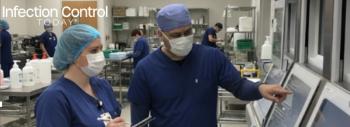
Editor's Letter: Tim and Monica's Story About Sepsis, Survival, and the Strength to Keep Going
I’ve known Monica and Tim forever, which is why their sepsis battles aren’t just “patient stories” to me. They’re a reminder that infection hides in ordinary days, and that vigilance, source control, and smart antibiotics save lives.
Monica Trapp and I have been friends since before we started kindergarten. Tim, her husband, became my friend simply because he was Monica’s. They are the kind of Ohio friends who become family—people you can text at midnight, the porch light always on, the coffee always hot, the dog always convinced he’s a lap puppy. When I sat with them to record this conversation, the dog was the first to remind us who runs the house, wedging himself under knees that—despite his confidence—he definitely no longer fits beneath. We laughed. And then we talked about sepsis.
I’m writing this in the first person because I don’t want you to read it as a distant case study or a tidy “patient story” with neat edges. This is my story about my friends. It’s about the way illness sneaks into ordinary life, the way a holiday weekend can complicate a discharge plan, and the way love looks when it’s measuring IV doses on the counter while the lasagna cools and the dog sighs at your feet.
The Backstory You Need
I remember vividly the phone call from Monica’s dad that Tim had had an accident that changed their lives. Tim became a quadriplegic in 1993 after a dive into shallow water—one of those before-and-after moments families never forget. He rebuilt life with the stubborn resilience that has always defined him. He, Monica, with daily assistance from her parents, learned the crafts of accessible living: transfers and cushions, wheel maintenance, skin checks, and a daily calculus of risk that most of us never have to do. Years later, a pressure injury required flap surgery that healed, until one spring day of joyful, too-long outdoor time on a backup cushion. The wound reopened. If you know pressure injuries, you know: They are not just wounds; they are schedules, supplies, clinic days, vigilance, and patience. They are also doorways through which infection can walk.
The First Sepsis—Born of a Stone
In late June 2021, just after Monica’s mom died of sepsis, Tim began to “feel really bad.” He ran a fever—105°F—and wanted only to sleep. He didn’t want to eat or drink. A nurse friend took one look and said, “Go.” The squad took him to the local emergency room. Staff suspected the wound; infection seemed plausible. But one attentive physician palpated Tim’s side, and he winced. A CT scan later, the news arrived bluntly: A large obstructing kidney stone had dammed the flow from the kidney; infected urine had nowhere to go.
“‘You’re going for a nephrostomy,’ they told us,” Monica remembered. “I was like—‘Right now?’ Right now.”
A nephrostomy tube is a lifeline in those moments: It is a small tube placed through the back into the kidney to drain urine externally. Drain the source. Cool the fire. Alongside that, Tim started IV antibiotics. Holiday timing made everything harder: Home IV arrangements stalled because that Monday was the observed July 4th holiday. He went home later than anyone wanted, with a PICC line and Monica trained to hang and flush medications because the home aide couldn’t handle the IVs. Tim felt wrung out. He told me he wasn’t afraid to sleep—exactly—but he also wasn’t exactly sure his body was ready to be home.
They couldn’t remove the stone immediately. Disturbing an infected, obstructing stone can pour bacteria into the bloodstream, so standard practice is to drain, treat, stabilize, and then schedule surgery. But this was midpandemic scheduling chaos. Operating rooms were backed up. The urologist’s vacation fell across the only window. It was August 13 before the stone finally came out. By then, the line between relief and exhaustion had blurred.
The Second Sepsis—Born of A Wound
The next time came on quieter feet. Tim was hospitalized again with changes at the wound site. The doctors suspected an abscess. There were days of “we think it’s this,” and “let’s just watch it,” and then the unmistakable proof of purulence. A surgeon placed a drain guided by imaging—“That’s a lot of pus,” someone in the room observed, and what an understatement. A wound VAC helped for a while, then didn’t; stitches helped and then didn’t; the wound looked small on the surface—a narrow slit—but ran 2 centimeters deep, the kind of geometry that fools the eye.
This is where the story tilts from clinical to human. Monica didn’t tell Tim, at least not right away, that he was septic again. The first time, when the ER team said, “You’re not going home; you’re too sick,” the word sepsis shot her straight back to her mother’s death. The grief was still fresh; the hospital was the same one. “That’s why he knew I was upset,” she said softly. “But I wouldn’t say it.” The second time, no one said the word at all until a nurse at a follow-up appointment did, almost offhandedly. “You were septic,” she said. Monica looked at Tim, and at the nurse, and realized they’d been walking a ridge again without a name for it.
What it feels like inside the fight
If you ask Tim what sepsis felt like, he’ll tell you he mostly knew he was tired to his bones. He wanted to sleep. As a quadriplegic, his body talks to him differently: Pain often registers as sudden sweating and a spike in blood pressure. When the nephrostomy tube shifted, he’d break into a full-body sweat. When an IV antibiotic (the kind pushed slowly through a syringe) triggered a reaction—rash around the neck and shoulders, breathless sweating—an urgent response team flooded the room, and antihistamines saved the day.
Afterward, he told the team to add that drug to the allergy list. “Zyvox? Penicillin? No,” he recited for me. “Mostly just penicillin—and now that one.” But the bigger truth hovered: the shelf of safe antibiotics narrows with every allergy label and every resistant culture. When pneumonia struck months later, levofloxacin worked, but it wiped him out. “The warning label says don’t exercise,” Monica said. “I told them, if there’s another option, we want it.”
The Quiet, Constant Courage of the Caregiver
Sepsis survival is not just the patient’s story; it’s the caregiver’s. Monica learned IV antibiotics because someone had to. She set alarms for doses, refilled flushes, argued the case for expedited imaging, and kept the long list of who-does-what straight in her head. She navigated the condescension of a specialist who made her feel small when she asked to be taught a Foley catheter change—something she needed to know to keep Tim safe at home. She tracked the secondary infections that complicate long admissions. She found the nurse practitioner who really listened. She kept the dog off the tubing, the laundry moving, and the humor alive.
I watched her face when she told me about the nurse who texted after discharge: I’m 3 miles away. If you ever need another set of eyes, call me. That’s the kind of medicine that keeps families going.
The Slow Climb Back
Recovery sounds like a grand word; it is mostly a series of small, stubborn choices. Tim said the first nights home felt fragile. Sleep was work. Appetite lagged. Getting shaved exhausted him. The PICC line and the antibiotic bags, the careful timing around meals—these things turned the day into stations on a long relay. “You just keep pushing,” he told me. “Once you start to feel a little better, your mind follows.” He laughed when he admitted there were moments in the hospital when he said the dark, quiet part out loud—Put me out of my misery—and then he shrugged like a man who has learned to forgive himself for human thoughts.
Monica worries differently now. Kidney stones hide in people who can’t feel them; you only know when the fever rises or the sweat breaks for no reason. Wounds can look tiny and travel deep. MRSA can colonize the everyday—sheets, surfaces, the inside of a memory. We talked about disinfectants and how bleach is not a cure-all, about laundry on “sanitize,” about the way knowledge both comforts and overwhelms. We talked about the impossible balance of using antibiotics wisely and still getting ahead of a pneumonia that isn’t reading the guidelines that day.
The Things That Helped
Here is what helped them, in their words and mine:
- A clinician willing to press gently on an abdomen and ask if something hurts. That palpation led to the scan that found the obstructing stone. You can’t treat what you don’t find.
- Drain first, then treat. The nephrostomy stabilized Tim when surgery couldn’t happen. The drain for the abscess did the same. Source control is not just jargon; it is mercy.
- Early, appropriate antibiotics, but not forever. Vancomycin for the wound when MRSA was likely; a second agent added quickly; narrow when you can. When the antibiotic caused a reaction, the team listened and stopped.
- A 30- to 90-day mindset for strength. Tim’s stamina did not return in a week; it came back in slow layers by sitting up longer, shaving, and transferring. He and Monica celebrated small wins.
- Community that shows up. Their nephew Trevor covered chores; friends rotated; a home nurse became a neighbor who stayed in touch. Even one helpful text could lift a day.
- Humor. You can’t measure its therapeutic index, but you can feel it. It is often the first medicine and the last thing you have energy for—and the thing that steadies the inbetween.
The Sharp Edges I Need to Say Aloud
There are warnings inside their story, and as someone who loves them, I want to say them clearly.
First, sepsis hides in plain sight. A high fever, profound fatigue, fast breathing, confusion, clammy skin, if you see these in someone who is high-risk, don’t “wait and see.” Tim didn’t feel pain from a kidney stone the way most do. What he felt was sweat and bone-deep tiredness. Monica’s nurse friend said, “Go,” and that probably saved his life.
Second, name the thing. Words carry power. Sepsis is not a scare word to withhold; it is a call sign that mobilizes attention, resources, and urgency. Families deserve to hear it because families shoulder the midnight watch. Monica shouldn’t have had to find out at a follow-up that, oh, yes, that was sepsis.
Third, antimicrobial resistance is not abstract. We talked—because I can’t not talk about it—about broad-spectrum antibiotics and the way we are marching ourselves back toward a prepenicillin world. Misuse doesn’t live only in headlines; it lives in reflex orders and “cover everything” habits. Tim’s pneumonia didn’t respond to what they were already giving. Levofloxacin worked, but it flattened him. We must steward these drugs like the finite treasures they are.
Fourth, pressure injuries are medical emergencies in slow motion. They require resources, precise cushions, strict time limits in chairs, and unapologetic boundaries about rest. The wound that reopened began as “a scratch.” It developed into an abscess filled with hundreds of milliliters of pus. If you’ve ever thought wound care is “just nursing,” let this paragraph correct you.
Finally, caregivers are a lifeline. Train them well. Honor their expertise. Don’t condescend when they ask to be taught how to perform a catheter change; they are not hobbyists. They are the reason tomorrow’s admission might not happen.
What Tim and Monica Would Tell You
When I asked Tim for his advice for anyone entering this storm, he laid it out plainly: “Stay positive. Listen to the doctors. Rest. And listen to your body—you know it better than they do.” Monica added the wisdom that comes from years of watching for subtler signs: “If something feels off, go. He’s not one to ask for the ER. When he said, ‘I can’t do this—take me,’ I knew.”
They also want you to know that it’s okay to say you’re scared. When Monica heard “septic” that first time, her mind catapulted back to her mother. She kept moving anyway, one checklist block at a time, because love is sometimes just the next dose, the next bandage, the next breakfast tray. It’s also the courage to ask a question twice and insist on the X-ray, to save the sputum cup for the doctor who will look, to text the nurse who said, Call me, because she meant it.
The Grace Notes
Not everything about the hospital was hard. They met kind nurses who made space for questions. A home-care nurse became a friend who still checks on them. There were days when the lab came on time, the veins behaved, and the pharmacy delivered early. There were days when Tim shaved without shaking, and Monica sat down before midnight. Their dog learned (again) not to snag tubing with his happy tail. There were evenings when the fever didn’t come back. If you’ve been there, you know that this is what grace looks like: not the absence of trouble, but the presence of enough light to take the next step.
Why I’m Telling You This
I’m telling you because sepsis is not rare. I’m telling you because the people you love might not display “classic” symptoms, and you may be the one who notices that the fatigue is different this time, that the sweat comes on suddenly, that the wound looks small but feels big. I’m telling you because hospitals, and holidays, and staffing shortages, and the very human limits of attention can stretch thin, and families become the net.
Mostly, I’m telling you because Tim and Monica are my dear friends, and their courage deserves daylight. He will shrug at the word courage; she will tell me I’m being dramatic. But I sat with them and listened to them recount a summer of fevers and tubes, of scheduling delays and hard choices, of MRSA in the bone and antibiotics that both heal and harm, of laughter that returns even after the body has been scarred. I heard the quiet relief in Tim’s voice when he said, “Once you start to feel a little better, your mind follows.” I saw the flint in Monica’s eyes when she said, “You know your body better than the doctors do.”
If you learn one thing from their story, let it be this: Sepsis is a race you don’t want to run late. If it’s a fever you can’t shake, a sudden fog, a breath you can’t catch, a wound that’s acting wrong—go. If you’re the partner, the child, the neighbor who suspects something isn’t right—say so. If you’re the clinician in the room, press the abdomen anyway, order the scan, drain the source, speak the word. And wherever you can, choose antibiotics like the limited miracles they are.
We finished our conversation the way we started it—laughing at the dog, who had decided, once again, that he is smaller than he is. The house hummed with the ordinary: the clink of ice, the shuffle of pill bottles, the familiar shorthand of 2 people who have done hard things together for a long time. Sepsis did not steal that from them. Nothing will.
Postscript: Since we recorded this interview, Tim has had sepsis again—twice. Both times, he ended up in the intensive care unit and almost didn’t make it out. Life now is a bit calmer, but they are always on the lookout in case of a “next” time.
Newsletter
Stay prepared and protected with Infection Control Today's newsletter, delivering essential updates, best practices, and expert insights for infection preventionists.





